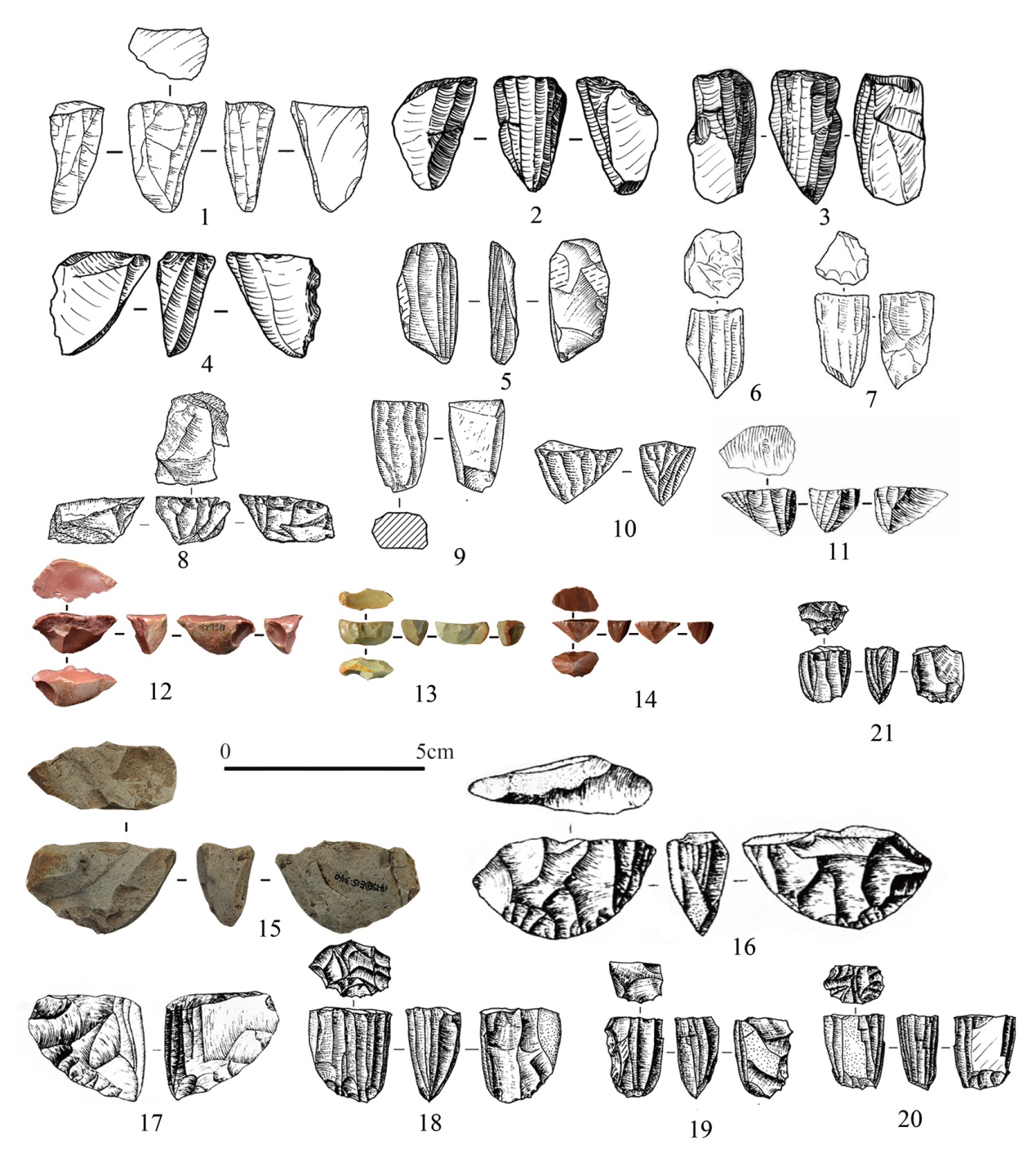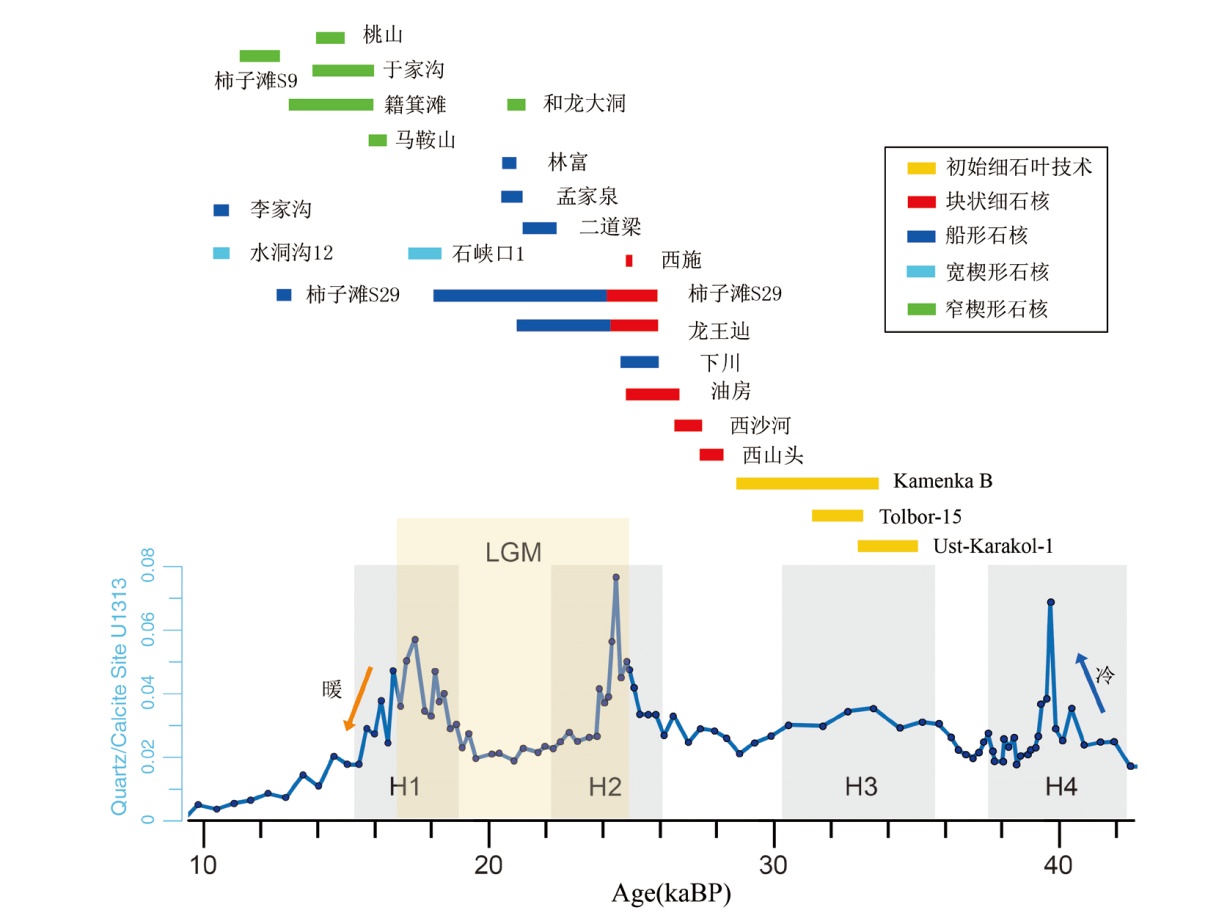| [1] |
陈胜前. 思考考古学[M]. 北京: 科学出版社, 2014
|
| [2] |
王幼平. 华北细石器技术的出现与发展[J]. 人类学学报, 2018, 37(4): 565-576
|
| [3] |
陈宥成, 曲彤丽. 试论华北旧石器时代晚期细石核的类型、组合与分期[J]. 考古, 2022(1): 75-83
|
| [4] |
贾兰坡. 中国细石器的特征和它的传统、起源与分布[J]. 古脊椎动物与古人类, 1978, 2: 137-143+159-161
|
| [5] |
裴文中. 中国细石器文化略说[A]. 中国史前时期之研究[M]. 北京: 商务印书馆, 1948
|
| [6] |
Geobel T. The “microblade adaptation” and recolonization of Siberia during the Late Upper Pleistocene[A]. In: Elston RG, Kuhn S (Eds). Thinking Small: Global Perspectives on Microlithization[C]. Archaeological Papers of the American Anthropological Association. Vol.12. Washington, DC: American Anthropological Association, 2002, 117-131
|
| [7] |
Yue JP, Yang SX, Li Y, et al. Human adaptations during MIS 2: Evidence from microblade industries of Northeast China[J]. Palaeogeography, Palaeoclimatology, Palaeoecology, 2021, 567: 110286
|
| [8] |
陈胜前. 细石叶工艺的起源:一个理论与生态的视角[J]. 考古学研究(七), 2008, 244-264
|
| [9] |
山西大学历史文化学院, 山西省考古研究所. 山西吉县柿子滩遗址S29地点发掘简报[J]. 考古, 2017, 593(2): 35-51+2
|
| [10] |
北京师范大学历史学院, 山西省考古研究所. 山西沁水下川遗址小白桦圪梁地点2015年发掘报告[J]. 考古学报, 2019, 214(3): 383-408
|
| [11] |
王小庆, 张家富. 龙王辿遗址第一地点细石器加工技术与年代:兼论华北地区细石器的起源[J]. 南方文物, 2016, 4: 49-56
|
| [12] |
Nian XM, Gao X, Xie F, et al. Chronology of the Youfang site and its implications for the emergence of microblade technology in North China[J]. Quaternary International, 2014, 347: 113-121
|
| [13] |
王幼平, 汪松枝. MIS3阶段嵩山东麓旧石器发现与问题[J]. 人类学学报, 2014, 33(3): 304-314
|
| [14] |
北京大学考古文博学院, 郑州市文物考古研究院. 2017年河南登封西施东区旧石器晚期遗址发掘简报[J]. 中原文物, 2018, 204(6): 54-61
|
| [15] |
Gómez Coutouly Y. The emergence of pressure knapping microblade technology in Northeast Asia[J]. Radiocarbon, 2018, 60(3): 821-855
|
| [16] |
杜水生. 连续与断裂:重新认识下川遗址在中国旧石器文化研究上的意义[J]. 第四纪研究, 2021, 41(1): 153-163
|
| [17] |
陈淳, 张萌. 细石叶工业研究的回顾与再思考[J]. 人类学学报, 2018, 37(4): 577-589
|
| [18] |
赵海龙. 细石叶剥制实验研究[J]. 人类学学报, 2011, 30(1): 22-31
|
| [19] |
杨石霞, 浣发祥, 王宏, 等. 广东西樵山细石叶石核的开发策略[J]. 人类学学报, 2022, 41(5): 804-815
|
| [20] |
Li F, Kuhn SL, Bar-Yosef O, et al. History, chronology and techno-typology of the Upper Paleolithic sequence in the Shuidonggou area, northern China[J]. Journal of World Prehistory, 2019, 32: 111-141
|
| [21] |
吉林大学考古学院, 黑龙江省文物考古研究所, 中国科学院古脊椎动物与古人类研究所. 黑龙江龙江县西山头旧石器时代遗址试掘简报[J]. 考古, 2019, 626(11): 3-13
|
| [22] |
Guan Y, Wang XM, Wang FG, et al. Microblade remains from the Xishahe site, North China and their implications for the origin of microblade technology in Northeast Asia[J]. Quaternary International, 2020, 535: 38-47
|
| [23] |
Song Y, Cohen DJ, Shi J, et al. Environmental reconstruction and dating of Shizitan 29, Shanxi Province: An early microblade site in north China[J]. Journal of Archaeological Science, 2017, 79: 19-35
|
| [24] |
李罡, 任雪岩, 李珺. 泥河湾盆地二道梁旧石器时代晚期遗址发掘简报[J]. 人类学学报, 2016, 4: 509-521
|
| [25] |
李有骞. 黑龙江省林富旧石器遗址的发现与年代[A].见:内蒙古博物馆,内蒙古自治区文物考古研究所(编).中国北方及蒙古、贝加尔、西伯利亚地区古代文化(上)[C]. 北京: 科学出版社, 2015, 121-130
|
| [26] |
岳健平, 侯亚梅, 杨石霞, 等. 黑龙江省桃山遗址2014年度发掘报告[J]. 人类学学报, 2017, 36(2): 180-192
|
| [27] |
关莹, 周振宇, 王晓敏, 等. 河北阳原泥河湾盆地籍箕滩遗址发现的新材料[J]. 人类学学报, 2021, 40(1): 137-145
|
| [28] |
Wang XM, Xie F, Mei HJ, et al. Intensive exploitation of animal resources during Deglacial times in North China: a case study from the Yujiagou site[J]. Archaeological and Anthropological Sciences, 2019, 11(9): 4983-5000
|
| [29] |
Liu LL, Wei G, Sheahan B, et al. Plant exploitation of the last foragers at Shizitan in the Middle Yellow River Valley China: evidence from grinding stones[J]. Journal of Archaeological Science, 2011, 38(12): 3524-3532
|
| [30] |
Yi MJ, Gao X, Chen FY, et al. Combining sedentism and mobility in the Palaeolithic-Neolithic transition of northern China: the site of Shuidonggou locality 12[J]. Antiquity, 2021, 95(380): 292-309
|
| [31] |
Bronk RC. Bayesian analysis of radiocarbon dates[J]. Radiocarbon, 2009, 1: 337-60
|
| [32] |
Reimer PJ, Austin W, Bard E, et al. The IntCal20 Northern Hemisphere radiocarbon age calibration curve (0-55 cal kBP)[J]. Radiocarbon, 2020, 62(4): 725-757
|
| [33] |
Graf KE. Uncharted territory: Late Pleistocene hunter-gatherer dispersals in the Siberian mammoth steppe[D]. Department of Anthropology, Reno: University of Nevada, 2008
|
| [34] |
Graf KE. Hunter-gatherer dispersals in the mammoth-steppe: Technological provisioning and land-use in the Enisei River valley, south-central Siberia[J]. Journal of Archaeological Science, 2010, 37: 210-223
|
| [35] |
Kuzmin YV, Keates SG, Shen C. Introduction:Microblades and Beyond[A]. In: Kuzmin YV, Keates SG, Shen C (Eds). Origin and spread of microblade technology in Northern Asia and North America[C]. Burnaby, British Columbia: Archaeology Press, Simon Fraser University, 2007, 1-6
|
| [36] |
Derevianko AP. The Middle to Upper Paleolithic Transition in the Altai (Mongolia and Siberia)[J]. Archaeology, Ethnology and Anthropology of Eurasia. 2001, 2(3): 70-103
|
| [37] |
Derevianko AP, Volkov PV. Evolution of lithic reduction technology in the course of the middle to upper paleolithic transition in the Altai Mountains[J]. Archaeology, Ethnology and Anthropology of Eurasia. 2004, 5(2): 21-35
|
| [38] |
Derevanko AP, Markin S. The Paleolithic of the Altai[A]. In: Derevianko AP, Shimkin DB, Powers WR (Eds). The Paleolithic of Siberia: New Discoveries and Interpretations[C]. Urbana, Chicago: University of Illinois Press, 1998, 84-106
|
| [39] |
Slavinsky VS, Rybin EP, Belousova NE. Variation in middle and upper paleolithic techniques of lithic reduction at Kara-Bom, The Altai Mountains: Refitting Studies[J]. Archaeology, Ethnology and Anthropology of Eurasia. 2016, 44: 39-50
|
| [40] |
Шуньков МВ, Белоусова НЕ. Среднепалеолитическая составляющая каменной индустрии из слоев 8-11 стоянки Усть-Каракол-1 (по данным планиграфического анализа)[J]. Проблемы археологии, этнографии, антропологии Сибири и сопредельных территорий. 2015, 11: 179-182
|
| [41] |
Derevianko AP, Petrin VT, Rybin EP. The Kara-Bom Site and characteristics of the middle-upper Paleolithic transition in the Altai[J]. Archaeology, Ethnology and Anthropology of Eurasia, 2000, 2: 33-51
|
| [42] |
Derevianko AP. Three scenarios of the middle to upper paleolithic transition: Scenario 1: the middle to upper paleolithic transition in Northern Asia[J]. Archaeology, Ethnology and Anthropology of Eurasia, 2010, 38(3), 2-32
|
| [43] |
Vasil’ev SA, Kuzmin YV, Orlova LA, et al. Radiocarbon-based chronology of the Paleolithic in Siberia and its relevance to the peopling of the New World[J]. Radiocarbon, 2002, 44: 503-530
|
| [44] |
Gladyshev SA, Olsen JW, Tabarev AV, et al. Chronology and periodization of Upper Paleolithic sites in Mongolia[J]. Archaeology, Ethnology and Anthropology of Eurasia, 2010, 38(3): 33-40
|
| [45] |
Zhang M. Rethinking microblade technology research in Northeastern Asia[J]. Journal of Paleolithic Archaeology. 2021, 4: 17
|
| [46] |
Деревянко АП. К вопросу о формировании пластинчатой индустриии микроиндустрии на Востоке Азии[J]. Археология, Этнография и Антропология Евразии, 2004, 4: 2-29
|
| [47] |
Gladyshev SA, Olsen JW, Tabarev AV, et al. The Upper Paleolithic of Mongolia: Recent finds and new perspectives[J]. Quaternary International, 2012, 281: 36-46
|
| [48] |
Yoshiaki Otsuka. The background of transitions in microblade industries in Hokkaido, northern Japan[J]. Quaternary International, 442, 33-42
|
| [49] |
万晨晨, 陈全家, 方启, 等. 吉林和龙大洞遗址的调查与研究[J]. 考古学报, 2017, 1: 1-24
|
| [50] |
Boserup E. The economics of agrarian change under population pressure[M]. Chicago: Aldine, 1965
|
| [51] |
Hayden B. Research and development in the Stone Ages: Technological transitions among hunter-gatherers[J]. Current Anthropology, 1981, 22(5): 519-548
|
| [52] |
Hodell DA, Channell JE, Curtis JH, et al. Onset of “Hudson Strait” Heinrich events in the eastern North Atlantic at the end of the middle Pleistocene transition (640 ka)?[J]. Paleoceanography, 2008, 23(4): PA4218
|
| [53] |
Naafs BDA, Hefter J, Gruetzner J, et al. Warming of surface waters in the mid-latitude North Atlantic during Heinrich events[J]. Paleoceanography, 2013, 28(1): 153-163
|
| [54] |
Elston RG, Kuhn S. Thinking Small: Global Perspectives on Microlithization[M]. Archaeological Papers of the American Anthropological Association. Vol. 12. Washington, DC: American Anthropological Association, 2002
|
| [55] |
Fairbanks RG. A 17,000-year glacio-eustatic sea level record: Influence of glacial melting rates on the Younger Dryas event and deep ocean circulation[J]. Nature, 1989, 342: 637-642
|
| [56] |
Tozer B, Sandwell DT, Smith WHF, et al. Global bathymetry and topography at 15 Arc Sec: SRTM15+[J]. Earth and Space Science, 2019, 6(10): 1847-1864
doi: 10.1029/2019EA000658
|
| [57] |
Ray N, Admas JM. A GIS-based vegetation map of the world at the Last Glacial Maximum (25,000-15,000 BP)[J]. Internet Archaeology, 2011, 11: 1-44
|






